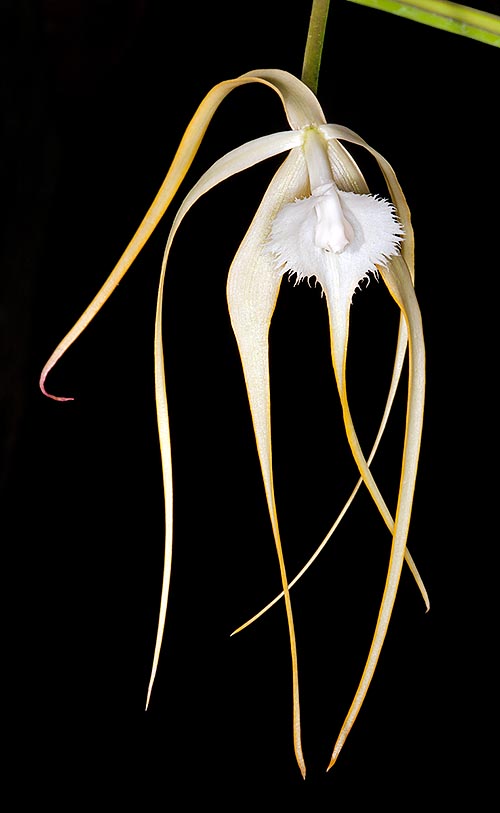Family : Orchidaceae

Text © Pietro Puccio

English translation by Mario Beltramini

The Brassavola cucullata is rather easy to cultivate © Giuseppe Mazza
The species is native to a vast area of tropical America (Belize, Colombia, Dominican Republic, El Salvador, French Guyana, Guatemala, Guyana, Honduras, Leeward Islands, Mexico, Nicaragua, Panama, Surinam, Trinidad and Tobago, Venezuela and Venezuelan Antilles), where it grows in the pluvial forests usually within the 500 m of altitude, even if it is possible to find it up to about 1800 m.
The genus is honoured to the Italian physician and botanist Antonio Musa Brassavola (1500-1555); the name of the species comes from the Latin term “cucullus” = hood, therefore, hooded, with reference to the shape of the labellum.
The Brassavola cucullata (L.) R.Br. (1813) is an epiphytic species with semi-erect or drooping pseudobulbs, on a short and creeping rhizome, up to about 20 cm long and about 0,3 cm broad, covered by tubular, white and membranous, sheaths, carrying at the apex a single persistent leaf, rigid, almost cylindrical, 18-35 cm long and 0,5-0,7 cm broad.
It has an inflorescence from the base of the leaf on a short peduncle, 1-2 cm, carrying 1-3 flowers on a particularly long stem (pedicel), 15-22 cm, with sepals and petals of a white to pale yellow colour with more or less intense brown-reddish shades, on the back and white labellum.
The sepals are linear-lanceolate, thinned near to the apex, 7-12 cm long and 0,6-0,8 cm broad, drooping, similar petals, but of a width less, about 0,4 mm, labellum 6-9 cm long and 1,5-2,5 cm broad, cordate at the base, trilobed, with lateral lobes, fimbriated at the margins, and long sharpened central lobe; the flowers, which bloom in summer-autumn, emit an intense scent during the night hours in order to attract the pollinating insects and last 3-5 weeks.
It reproduces by seed, in vitro, and by division, with each section provided with 3-4 pseudobulbs at least. Its is a particularly enticing species and of a rather easy cultivation, as it adapts to different situations, as it is proved by the vast range of origin, suitable for temperate-warm climate with night low temperatures of 13-15 °C, even if it can stand for short time and if dry to some degrees less, 20-30 °C by day, but it is capable to bear also higher temperatures.
It requires high luminosity, also some direct sunlight in the morning and/or by late afternoon, and humidity, 60-80%, and good and constant ventilation. During the growth period of the pseudobulbs, the waterings must be regular and abundant, but duly spaced in way to allow the roots to dry up completely, after the flowering the waterings are to be reduced thus to allow a short resting time, but preventing the leaves to wrinkle. For the waterings and the nebulisations, is to be utilized rain water, or water obtained by reverse osmosis, or demineralised; the fertilizations, duly distributed in way to avoid salts accumulation, are to be done during the vegetative period preferably with hydrosoluble balanced products, with microelements, at half dosage, or less, than what suggested on the package.
Both for the drooping posture and for avoiding water stagnations, to which it is particularly sensitive, it is to be preferably mounted on bark, trunks, rafts of cork or of arborescent ferns roots, or, at the most, in small baskets with a much draining and aerated compost, that can be formed by medium-sliced bark fragments; it does not love to be disturbed, therefore repotting and shifts are to be done only when strictly necessary.
The species is reported in the appendix II of the CITES (species whose trade is internationally ruled).
Synonyms: Epidendrum cucullatum L. (1763); Cymbidium cucullatum (L.) Sw. (1799); Brassavola cuspidata Hook. (1839); Brassavola appendiculata A.Rich. & Galeotti (1845); Brassavola odoratissima Regel (1852); Bletia cucullata (L.) Rchb.f. (1862).
→ For general notions about ORCHIDACEAE please click here.
